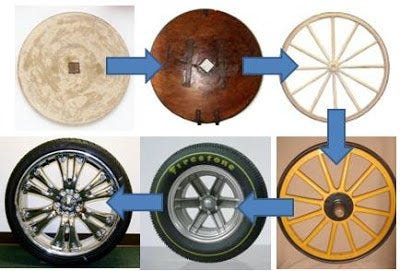One of the most important regions of technological advances was the North Pontic steppe, where innovations accelerated human mobility via early wheeled vehicles, pulled by horses. Some of the oldest known chariots have been found in burials of the Sintashta culture in modern-day Chelyabinsk Oblast, Russia, dated to c. 1950-1880 BCE and on cylinder seals from Central Anatolia in Kültepe dated to c.1900 BCE.
Further technological progress came in developing metallurgy and copper alloying, objects that can be attributed to Eurasian cultures Alakul, Abashevo, Sintashta, Petrovka and Srubnaya. These cultures flourished through horse-enabled contact and exchange across the forest-steppe zone connecting agrarian lands with the steppes, spreading horse technology and metallurgy through vast techno-cultural networks spanning across Eurasia, such as Bactria-Margiana complex between Central Asia, Near East and India, or the Seima-Turbino phenomena ranging from Siberia to Scandinavia.
The extension of Seima-Turbino phenomena techno-complex
In colder environments, horses were used to pull sleds and skis in the forest-steppe and taiga, carrying loads and humans over long distances on snow and ice. The Rostovka cemetery is considered to be the “center” of the Seima-Turbino phenomenon, and is known for some of the more interesting horse-related finds such as the blades decorated with what seemingly seems to be a man on skis being pulled by horses. The age of these findings suggest that horses were used to pull humans in sleds very early in the bronze age, possibly even earlier than the use of horses to pull carts, wagons and riding. Regardless of whether sleds were pulled before wagons, the vastness of these early techno-cultural networks would unlikely be possible to achieve without the mobility enabled by horses.
Decorative bronze artifacts from Seima-Turbino depicting early horse-pulled sleds c.1900 BC
The first horse chariots were a type of cart driven by a charioteer, usually using horses to provide rapid motive power. The critical technological invention that allowed the construction of light, horse-drawn chariots was the spoked wheel. The invention of the chariot was a game-changer and it revolutionized warfare, giving armies greater mobility and speed. The chariot was a lightweight, two-wheeled vehicle pulled by horses that allowed for fast and efficient movement on the battlefield and superiority in fast-paced warfare.
The evolution of the wheel from solid to spoked - stone, wooden, metal and rubber
Another significant invention was the stirrup. The stirrup allowed riders to stand on the horse's back and use their body weight to maneuver the animal. The stirrup provided a significant advantage in combat, allowing for greater stability and control. It enabled mounted archers to ride hands-free and shoot from standing positions, greatly increasing the accuracy and speed of their shooting. Stirrups also enabled the rider to take cover behind the moving horse under enemy fire while riding. The use of stirrups enabled the rise of mounted cavalry that largely replaced the use of chariots in warfare by 300 BCE.
The Age of Exploration saw a new kind of horse-powered mobility with the introduction of the horse-drawn carriage. This allowed for greater ease of travel and trade, as well as social status for those who could afford it. The Industrial Revolution brought about a new era of transportation with the invention of the steam engine and later, the automobile, replacing the need for horses in mobility.
Some important historical advances in horse-related technology were:
- The wagon, a cart with solid wheels which was pulled by horses, enabled for the first time long-distance transport of people and goods. By 3000 BCE, horse-pulled wagons emerged rapidly replacing the neolithic carts pulled by oxen and donkeys.
- The spoked wheel, which was invented around 2000 BCE and enabled the construction of light and fast chariots that were used for war and racing. The spoked wheel also improved the efficiency and speed of carts and wagons.
- The war chariots, which were lightweight and fast, enabled more efficient warfare tactics enhancing the military might of the first empires
- The saddle, which was developed around 700 BCE and provided stability and comfort for riders. The saddle also allowed riders to carry weapons and equipment more easily.
- The stirrup, which was introduced around 300 CE and gave riders more balance and control over their horses. The stirrup also enabled new forms of cavalry tactics and warfare, such as shock combat and mounted archery.
- The horse collar, which was invented around 800 CE and improved the pulling power of horses by distributing the weight on their shoulders instead of their necks. The horse collar also reduced the risk of injury and suffocation for horses.
- The horseshoe, which was developed around 900 CE and protected the hooves of horses from wear and tear. The horseshoe also improved the traction and performance of horses on different terrains.
- The composite bow and arrow, enabling fast, standing-position archery from horseback.
- The magnetic compass, which enabled mariners to navigate using horses as a motive power.
- The mechanical sower, which improved agricultural productivity by using horses to pull the device that planted seeds.
- The sled, which was pulled by horses and was used as a means for transport over snow and ice.















Share this post